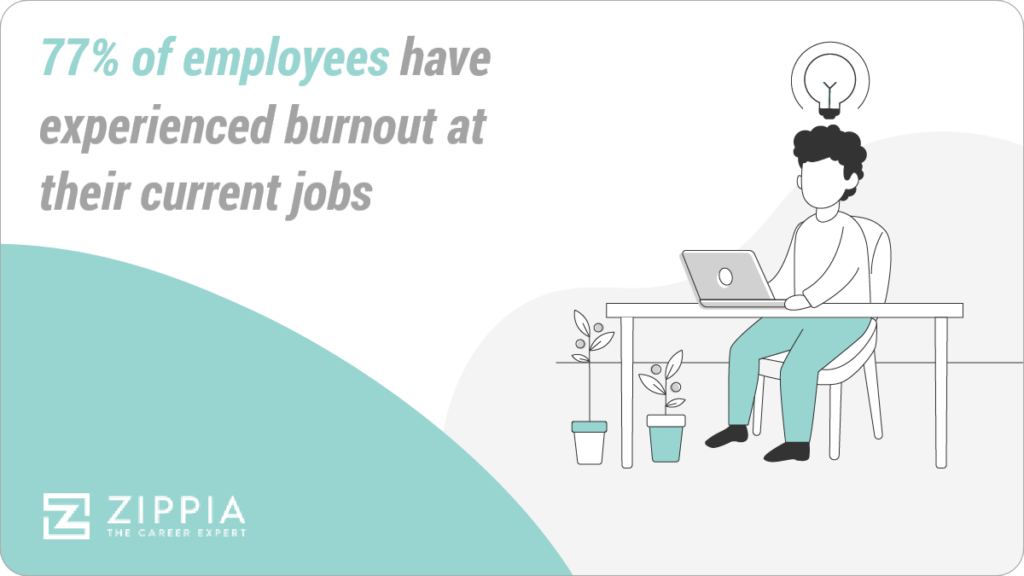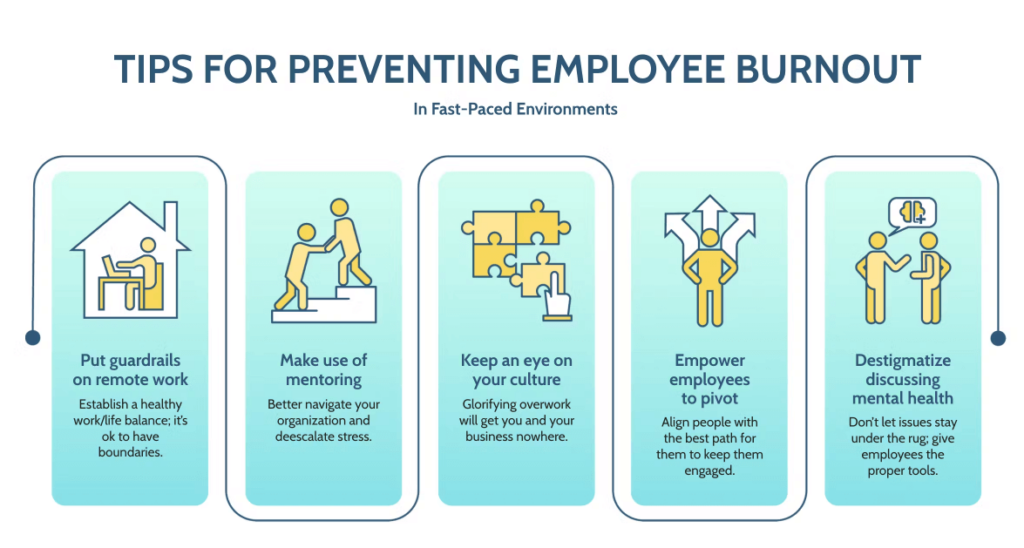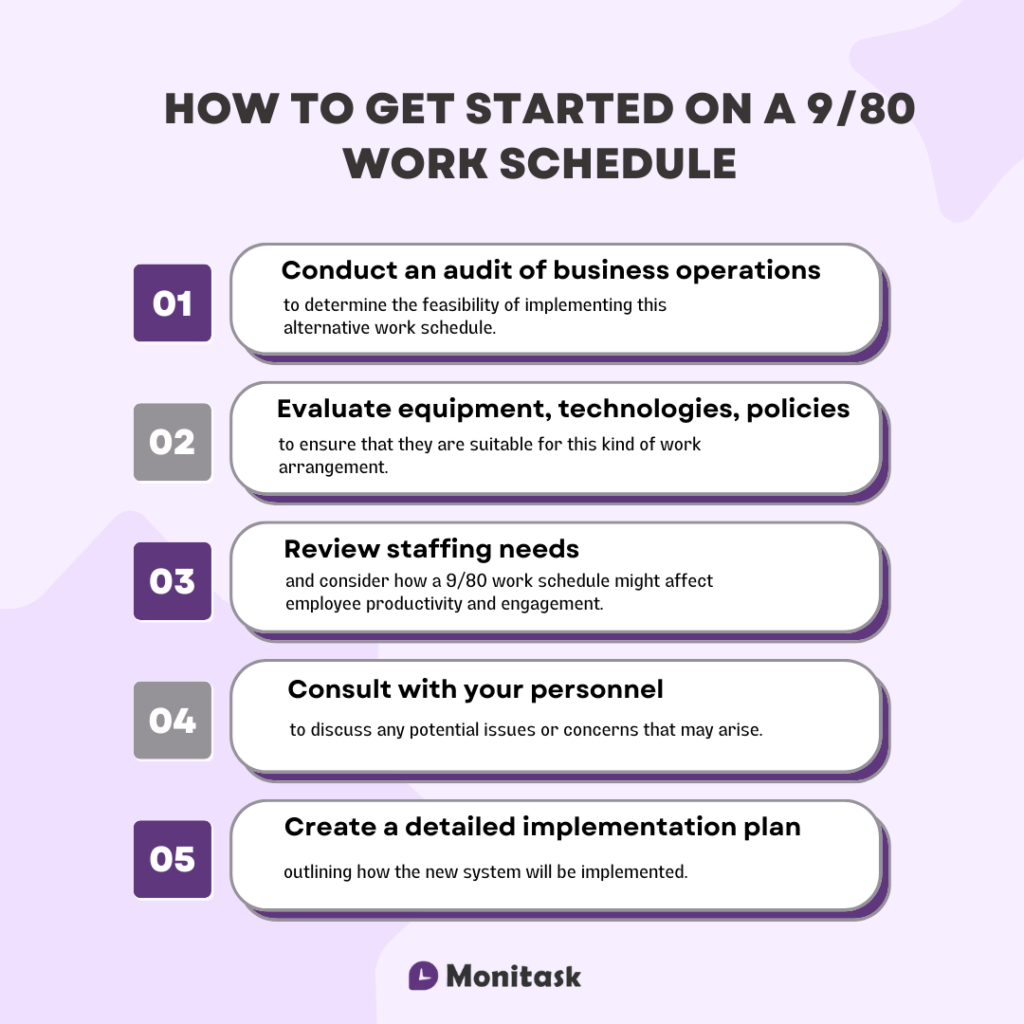What Is a 9/80 Work Schedule

Better work life balance is an objective many employees strive for in their professional lives. A 9/80 work schedule is one method companies are using to help their employees achieve their goals. This unique, new schedule allows employees to work extra hours over a two week period, which can then be compensated with additional time off, enhancing employee productivity and satisfaction.
By granting employees control over their time, companies can foster a more conducive work environment that ultimately results in improved output and job satisfaction. In this blog post, we’ll explain what a 9 80 schedule is, the pros and cons of such a schedule, and how to implement them in your business.
Get more out of your business
Get the best employee engagement content every week via mailing list

What is a Flexible Work Schedule?
Flexible work schedules are a type of arrangement in which employees are given more control over their working hours. This includes allowing them to decide when and how long they work on certain days, as well as the ability to work remotely or from home. It gives employees more freedom and autonomy in managing their own time, while also providing organizations with improved efficiency and productivity.
Recent reports note that the majority of millennials and Gen Z would like the opportunity to work from home and/or have flexibility. In the future, it is highly probable that flexible working will transition from being an exception to becoming the norm in numerous professions. Flexible work shouldn’t be confused with remote work – although some flexible schedules may include working from home, it is not a requirement.
What Is a 9/80 Work Schedule?
A 9/80 work schedule is a type of flexible work schedule where employees work eight nine hour days and one eight hour day in a two weeks period, totaling 80 hours. Typically, in the first week employees work four nine hour days per week, followed by one eight hour day, and then enjoy a three day weekend in the second week. This schedule is popular among employers and employees because it provides more extended time off over two separate weeks, and it has been shown to improve employee productivity and job satisfaction.
Example of a 9 80 Schedule
Let’s say that a company decides to implement the 9 80 schedule for its employees. The workweek starts on Monday and ends on Friday. An employee works from Monday to Friday, from 8:00 a.m. to 5:00 p.m., with an hour-long unpaid lunch break. In a two weeks period, they would work four nine hour days (8:00 a.m. to 6:00 p.m.) from Monday to Thursday, and one eight hours day (8:00 a.m. to 5:00 p.m.) on Friday of the first week, totaling 44 hours worked.
In the following second week, employees would work four nine hour days (8:00 a.m. to 6:00 p.m.) from Monday to Thursday being Friday as the day off, totaling 36 work hours. In this example, the employee would end up working 80 hours in two weeks and still enjoy an extra day off each week without any reduction in their wages or benefits.
What Are the Pros of a 9 80 Work Schedule?
Improved Work Life Balance
77% of surveyed employees say they’ve experienced burnout at their current job, which can negatively affect their work performance and morale. This alternative schedule is popular because of its ability to provide employees with better work life balance. The extended periods of time off make it easier for employees to find time for personal activities, family commitments, or calling in for a sick day, if necessary. This results in increased job satisfaction and employee retention, since satisfied employees are more likely to stay with a company longer.

Boosted Employee Productivity
Productivity levels are often linked with an employee’s working hours – a well-rested employee is a productive one. The additional time off provided by a 9 80 schedule can lead to increased productivity during working hours. Flexible work is a key driver for productivity! In the Gartner 2021 Digital Worker Experience Survey, a significant 43% of respondents emphasized that having flexible working hours contributed to heightened productivity levels.
This can be due to employees feeling more refreshed and rejuvenated after their longer weekends. The compressed work schedule allows employees to have uninterrupted work periods which can lead to higher productivity. Employees who worked a compressed work schedule perceived less work interference with personal life, reported a positive work climate, and had higher job performance ratings.
Higher Retention Rates and Improved Hiring Process
Offering a 9/80 work schedule can significantly boost a company’s retention rates and enhance the hiring process. Employees, when given the option to manage their time effectively, tend to stay longer with the organization. This helps businesses to save considerable resources in the long run due to the reduced need for hiring and training new employees.
According to a SHRM report, 55% of employees stated better work life balance and personal well-being as the most critical aspect when considering a job offer. By providing a flexible schedule like the 9/80, companies can attract a larger pool of potential candidates, including those who prioritize work-life harmony. This work schedule can be a crucial strategy for companies aiming to attract and retain top talent in today’s competitive job market.
Enhanced Trust and Empowered Flexibility
Granting employees a 9/80 work schedule can foster an environment of trust and mutual respect in the workplace. By providing this flexible schedule, employers demonstrate their trust in employees’ ability to manage their work time effectively. This trust can lead to employees feeling more valued and respected, which in turn, encourages a higher degree of commitment and loyalty to the organization.
Furthermore, the inherent flexibility of a 9/80 schedule empowers employees with the ability to better balance their professional and personal commitments. This can significantly enhance job satisfaction and reduce stress, leading to healthier employees both mentally and physically. The reduction in stress can also lead to a decrease in absenteeism and workplace conflict, contributing to a more harmonious and productive work environment.
Minimized Time Spent on Commuting
For many employees, commuting is a major source of stress and wasted time. The 9 80 work schedule effectively reduces the number of commuting days, allowing employees to save on travel time and expenses. Additionally, it contributes to a reduction in carbon emissions, aligning with the growing emphasis on environmentally friendly practices in the workplace.

It’s worth highlighting the impact of a 9 80 work schedule on peak-hour traffic congestion. Having a day off during the traditional workweek contributes to less crowded roads and public transportation during peak hours. This not only benefits the employees on a 9/80 schedule but also aids in reducing overall traffic congestion, a vital factor in improving urban livability and lowering pollution levels.
What Are the Cons of a 9/80 Work Schedule?
Extended Working Hours
While a 9/80 work schedule offers several attractive advantages, one significant downside is the requirement for extended working hours on workdays. Employees who are accustomed to an 8-hour workday may find the extra hour burdensome, as it extends the workday into the evening. This could lead to fatigue, decreased productivity, and potentially, a decline in work quality.
Furthermore, those with family obligations or after-work commitments may find it challenging to adapt to the elongated workday, which can negatively impact work life balance. Another aspect to consider is the potential for increased stress levels associated with longer workdays. Working a nine hour day could place an extra mental strain on employees, particularly those involved in intensive or high-pressure roles.
Scheduling Conflicts
Another potential downside of the 9/80 work schedule is the emergence of scheduling conflicts. If not everyone in the office is on the same schedule, coordinating meetings or collaborative work can prove challenging. This issue can be particularly pronounced in teams with overseas members operating in different time zones, or those in industries with 24/7 availability service.
Moreover, the 9/80 schedule can cause issues with customer service. If customers expect service five days a week, a company with employees on a 9/80 schedule might not meet these expectations, primarily due to reduced availability during regular business hours. This alternative work schedule may not be suitable for certain roles that require a high degree of availability or specialized expertise.
Payroll and Overtime Management
Payroll management can prove to be more challenging with a 9/80 work schedule. It’s critical to ensure that employees are compensated correctly, without incurring unnecessary overtime. This requires defining the work week precisely to avoid crossing into overtime territory. The process may demand additional administrative resources and careful record-keeping to stay compliant with labor laws.
The best way to avoid overtime pay with a 9/80 work schedule is by closely tracking employees’ hours and staying within the 40-hour threshold. This may be complicated in industries with changing workloads, where it can be difficult to predict employee hours precisely. Companies must consider the overtime laws of their state when adopting a 9/80 schedule.

Managing Paid Time Off (PTO)
A critical challenge of the 9 80 work schedule is the management of PTO, sick leave, and vacation time. The elongated workday necessitates a reevaluation of how these benefits are calculated and allocated. Traditionally, employees would take a day off, which equates to an eight hour workday. However, under the 9/80 arrangement, a workday is a 9 hour shift schedule.
Therefore, if an employee takes a day off or sick time, ideally one hour is deducted from their PTO balance. This adjustment can complicate the administration of time off, as it adds another layer of complexity to the HR department’s tasks. It also requires clear communication to employees about how their PTO is calculated and used, to prevent any misunderstandings or grievances. The same principles apply to sick leave, vacation time, or when a holiday falls on the weekday.
Unreachable Clients and Business Partners
Another notable disadvantage of the 9/80 work schedule concerns the accessibility to clients and business partners. Businesses operating with a 9 80 schedule may encounter difficulties in reaching clients and partners on their day off. This could potentially lead to communication delays and negatively impact customer service, especially in industries where immediate responses are essential.
Likewise, businesses may face situations where their clients, vendors, or partners are operating on a traditional nine to five work schedule. These entities might have expectations of weekday accessibility, and a non-traditional schedule can lead to missed opportunities or communication gaps. Before implementing a 9/80 schedule, companies must carefully consider the potential impact on client relations and HR business partners.
4/10 or 9/80 Work Schedule
The four hours ten work schedule is another alternative to the traditional 9/5 work week that has gained traction in recent years. Under this arrangement, employees work four days a week, putting in 10 hours each day, with three days off. This model provides employees with a longer continuous break, which could lead to improved work life balance.
However, it demands a longer working day and may not be suitable for all industries. In comparison, to the four hours ten work schedule the 9/80 work schedule provides more flexibility in terms of days off and total hours worked. Employees get to choose which two days they want to take off and when they prefer to start and finish their workday. This can make it easier for employees with commitments or specialized roles to find a schedule that suits their needs.
Is the 9/80 Work Schedule Suitable for Your Business?
Business Operations
The implementation of a 9 80 work schedule can significantly impact a company’s business operations. Decisions about business hours, workload distribution, and customer service must be carefully considered. The schedule must align with the company’s operational requirements and client demands.

Moreover, workload management becomes essential to prevent employee burnout, as the longer days may be more strenuous. This might require redistributing tasks or modifying deadlines to accommodate the new schedule. The company also needs to ensure that its technological infrastructure, such as software and communication tools, can effectively support alternative schedules.
Industries Well-Suited For The 9/80 Schedule
Certain industries are particularly well-positioned to successfully adopt the 9/80 schedule. These industries typically feature flexible workloads, project-based tasks, and less dependence on continuous customer service. Some examples include:
- Information Technology (IT): In the IT realm, work often revolves around projects that do not require constant customer interaction.
- Engineering and Architecture: The 9 80 schedule can be highly beneficial for these project-based industries, providing ample time for focused and uninterrupted work.
- Non-Profit Organizations: Many non-profits may find the 9/80 work schedule beneficial as it allows more flexibility.
- Research and Development (R&D): R&D departments, often operating under flexible deadlines and not requiring continuous customer interaction, can successfully implement a 9/80 work schedule.
Challenging Industries For The 9/80 Schedule
While the 9/80 work schedule can bring many benefits to both employers and employees, there are certain industries, or for small businesses where the implementation of this model might pose challenges. These include:
- Retail and Hospitality: These sectors are heavily customer-service oriented, require continuous availability, and often entail shift work.
- Healthcare and Emergency Services: In these fields, the professionals need to be accessible around the clock to avoid gaps in all the shifts.
- Education: Schools generally follow a traditional five-day work week, and teachers and administrators need to be available when students are present.
- Financial Services: Banks and financial institutions often need to align their working hours with stock market opening times and other financial institutions.
Staff Consultation
Before the implementation of any change to the work schedule, it’s crucial for businesses to consult with their staff. Changes in work hours can have significant personal and professional implications for employees. A shift from a traditional schedule to a 9/80 or 4/10 model can affect their personal lives, commuting patterns, child care arrangements, and overall job satisfaction.
During the consultation process, employers might consider conducting anonymous surveys to gauge the employees’ comfort with the proposed changes. These surveys can focus on critical aspects such as preferred work hours, potential challenges, and anticipated benefits. Employers should also be open to feedback and ready to make adjustments based on the employees’ input.
Resources
The decision to implement an alternative schedule such as the 4/10 or 9/80 model should not be taken lightly. It requires a thorough understanding of the company’s operations, an assessment of the workforce’s needs, and a careful review of local labor laws. To ensure that the transition runs smoothly, businesses should have at hand the necessary resources, such as a comprehensive employee handbook outlining the new work schedule, tools to simplify payroll and time off management, and software for communication and collaboration.

Implementing a 9/80 Work Schedule: Tips and Best Practices
Evaluating the Suitability of this Schedule for Your Business
Not every organization will find the 9/80 schedule suitable. The crucial determining factors are the nature of the industry, the demands of the business, and the needs of the employees. Businesses that require a consistent presence during the entire working week, such as retail or customer service, may find this schedule challenging to implement this flexible scheduling.
- What is the nature of your business? Does it require a constant presence throughout the week or does it operate on a project-based system?
- How will this schedule impact your employees’ work-life balance? Does the nine hour workday align with their personal obligations and lifestyle?
- How adaptable is your workforce to longer workdays? Are they comfortable with the notion of working for longer hours for fewer days in a week?
- Does your technological and operational infrastructure support this schedule? Can your existing systems effectively accommodate the change in work hours?
- Have you considered the potential impact on client service and relationships? Will this new schedule align with your customer service commitments and expectations?
Strategies for Achieving Organizational Buy-In
In order to ensure the successful implementation of a 9/80 work schedule, employers need to first create organizational buy-in. This can be accomplished by clearly communicating the potential benefits and advantages of this system for both the business and its employees.
To motivate teams, highlight the advantages such as increased productivity due to longer uninterrupted periods of work. Additionally, emphasize the potential benefits to employees such as increased job satisfaction, more control over their work-life balance, and more free time.
Set the Day Off
Once the decision to adopt a 9/80 work schedule is made, employers need to determine when employees will take their extra day off. This should be determined in consultation with the workforce and might involve polling them on their preferred days off. Ideally, the entire organization should have a fixed day off to facilitate communication and collaboration between teams.
However, if a fixed schedule of the day off is not possible due to operational requirements, it’s best to rotate the days off among teams or departments to prevent employee burnout and ensure that the company operation is covered throughout the week, avoiding disruptions or delays. To maintain a consistent system, employers should consider setting up an organized rotation schedule for the extra day off that can be reviewed periodically.
Pilot and Training
Organizations should conduct a pilot test schedule of the new system to assess its impact on productivity and employee satisfaction. During this period, employers should ensure that their staff is properly trained in the use of systems or technologies supporting this schedule, such as remote access tools and cloud-based solutions.

Additionally, they must provide clear guidelines regarding communication protocols and work expectations for employees working from home. Companies should also create support networks for their staff to provide assistance with any issues that may arise during the transition period.
Policy Update
To ensure that the new system is properly understood and implemented, employers should update their internal policies. This includes updating existing company handbooks to include information on the 9/80 schedule, its benefits, rules, and regulations.
These policies should clearly define expectations for both employees and managers regarding productivity standards, performance evaluation criteria, overtime wages regulations, etc. Finally, to ensure that the policy is properly understood and followed by all staff, employers should hold regular training sessions or workshops to reinforce its terms and conditions.
What Other Flexible Benefits Can You Offer Your Employees?
Health Reimbursement Arrangements (HRAs)
According to a survey, 56% of U.S. adults with employer-sponsored health benefits consider their satisfaction with their health coverage as a crucial determinant when deciding to remain in their current job. Health reimbursement arrangements (HRAs) can be one of these options. These are a type of flexible benefit that allows employers to contribute money to an employee’s health insurance plan.
Employees can then use the pre-tax dollars they receive from their employers to pay for medical expenses, such as doctor visits, medication, and vision care costs. HRAs are beneficial for both employees and businesses because they allow employees to save money on their healthcare costs while employers also enjoy tax savings.
Employers providing an HRA can offer a monthly allowance for eligible medical expenses such as health insurance premiums and qualified out-of-pocket expenses. With the flexibility to customize the HRA, employers can determine the reimbursement options for medical expenses and set a monthly allowance for employees to utilize.
Employee Stipends
Employee stipends are another type of flexible benefit that companies can provide to their employees. Stipends are regular payments made to employees for expenses related directly or indirectly related to their jobs such as travel, equipment, and lodging costs.
These financial assistance payments can be structured in a number of different ways, including lump sums, fixed per diems, or a combination of both. Stipends provide employees with a sense of financial security and allow them to cover expenses related to their work without taking on additional debt or using savings.
How To Get Started On A 9/80 Work Schedule
To get started on a 9/80 work schedule, employers should conduct an audit to assess their current operations and determine the feasibility of implementing such a system. This should include an evaluation of existing equipment, technologies, policies, and procedures to ensure that they are suitable for this kind of work arrangement.

Additionally, companies should review their staffing needs for shift coverage and consider how a 9/80 work schedule might affect employee productivity and engagement. Once the feasibility of a 9/80 schedule is established, employers should then consult with their personnel to discuss any potential issues or concerns that may arise.
Finally, companies should create a detailed implementation plan, outlining all the details on how the new system will be implemented and managed. This should include setting up systems and technologies to support the new system, training employees on new protocols and procedures, updating policies and handbooks, etc.
Streamline Your Scheduling Process with Effective Tools
To implement a 9/80 schedule effectively, it is beneficial to utilize tools designed for scheduling and productivity tracking like Monitask. By using the right technology and taking a proactive approach, employers can cultivate an efficient and productive workforce that is more engaged with their work. Here are some tips on how to do so:
- Use an automated scheduling feature: Monitask allows you to set the specific hours for each day, ensuring that employees adhere to the schedule and preventing any confusion or miscommunication.
- Track productivity: Tracking productivity is essential to ensure that the alternative work schedules are serving its purpose of increasing efficiency and output.
- Communication is key: Make sure your employees understand the schedule, what the work week involves, its benefits, and what is expected of them.
- Monitor and adapt: Some employees might struggle with the longer workday, while others flourish. Be flexible and willing to adapt the schedule based on the needs of your workforce.
- Provide the necessary resources: Make sure your employees have the tools and resources they need to succeed in this new schedule.
Conclusion
The 9/80 work schedule can provide a number of benefits to both employers and employees alike. It allows for greater flexibility, boost productivity, better employee engagement, and cost savings. However, it is important to take the time to properly plan and implement such a system to ensure that these advantages are realized.
Using tools like Monitask can help streamline the process and ensure that everyone is on board with the new system. By taking these steps, employers and employees can be sure to reap the rewards of a 9/80 work schedule while managing any potential downsides.
-The Monitask Team
Frequently Asked Questions
Is a 9/80 Schedule Good?
A 9/80 schedule can be beneficial, providing better work life balance and increased productivity. However, it might not suit every organization or employee. Thus, assessing compatibility and open communication is key to ensuring its success.
What is the Difference Between 9/80 and 4/10?
A 9/80 schedule refers to a two week period divided over nine days, with one day off, resulting in a three day weekend every two weeks. On the other hand, a 4/10 schedule means working four days a week for ten hours each, resulting in a consistent three day weekend.
What Are the Pros of a 9/80 Work Schedule?
The pros of a 9/80 work schedule include improved work life balance, increased productivity, reduced commuting times, and cost savings for the organization due to fewer workdays. However, its success depends on the nature of the job, the leadership team and the organizational culture.


